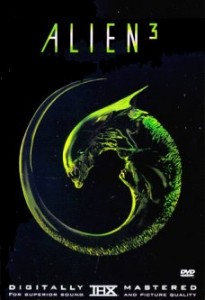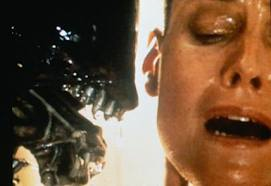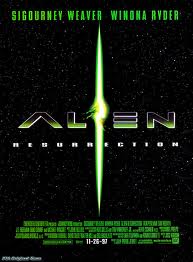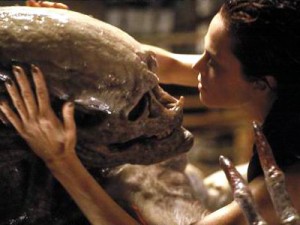Last week’s post from 2012—as this one is—addressed two cross-genre, sci-fi/horror classics, Alien and Aliens. Trust me, the praise will not be as effusive for Alien 3 or Alien: Resurrection. Still, they’re part of the quadrilogy and deserve some thoughts, so here goes.
3 TIMES THE SUSPENSE, 3 TIMES THE TERROR, 3 TIMES THE DANGER
 I’ll begin with a true scenario from the past. The year is 1992, and I’m ecstatic over the fact that, after another long wait of six years, a sequel to the awesome Aliens, one of my favorite films and arguably the best sequel to any movie ever made, is about to be released. We left Ripley, Newt, Hicks, and what remained of Bishop—a tight little family—in hyper-sleep on their way back to Earth. Given what the tagline promised, I could only imagine what they’d be getting themselves into now. THREE TIMES everything that happened in Aliens? Wow!
I’ll begin with a true scenario from the past. The year is 1992, and I’m ecstatic over the fact that, after another long wait of six years, a sequel to the awesome Aliens, one of my favorite films and arguably the best sequel to any movie ever made, is about to be released. We left Ripley, Newt, Hicks, and what remained of Bishop—a tight little family—in hyper-sleep on their way back to Earth. Given what the tagline promised, I could only imagine what they’d be getting themselves into now. THREE TIMES everything that happened in Aliens? Wow!
I go to see Alien 3 with a friend, who’s just as pumped as me. The opening credits begin to roll as the story unfolds. Yep, there’s the spacecraft Sulaco, with Ripley and the others in their sleep tubes. But there is also an Alien egg on board. How did…? A facehugger pops out and cracks the glass on Ripley’s tube. Hmm, wonder what it’s doing. It drips some acid, which causes havoc on the ship. Safety systems kick in; the sleep tubes are loaded onto a pod, which is ejected into space. By the time the pod lands on a planet called Fiorina “Fury” 161 Hicks has been crushed to death, Bishop is in even more unsalvageable pieces, and Newt has drowned in her sleep tube.
NEWT HAS DROWNED IN HER SLEEP TUBE!?!
I turn to my friend, who is shaking his head in disbelief, and utter three words, one of which you can figure out: “NO F***ING WAY!”
Newt, the sweet little girl—Ripley’s sole motivation for her heroic actions at the end of Aliens that gave us one of the best extended scenes ever filmed—is dead within the first five minutes of Alien 3. To tell the truth, neither of us much cared what happened after that.
 Well, what did happen was this: Ripley is saved by a doctor named Clemens, who tells her that Fury, a former mining planet—owned by The Company, of course—is now a penal colony populated and self-governed by convicted murderers and rapists. With no women on the planet—until now—they’ve all turned into celibate, fundamentalist Christians. Ripley is ordered to remain in sick bay until The Company, which has been notified of what happened, can come and get her.
Well, what did happen was this: Ripley is saved by a doctor named Clemens, who tells her that Fury, a former mining planet—owned by The Company, of course—is now a penal colony populated and self-governed by convicted murderers and rapists. With no women on the planet—until now—they’ve all turned into celibate, fundamentalist Christians. Ripley is ordered to remain in sick bay until The Company, which has been notified of what happened, can come and get her.
Another facehugger has impregnated a prisoner’s Rottweiler, and when the chestburster appears—well, we all know the drill. One huge Alien—count ’em, one—now stalks the gloomy corridors of Fury, while Ripley deals with all of the lowlifes, some of whom want to kill her, others hoping to denounce their celibate ways. One by one, two by two, they’re knocked off by the Alien, until Ripley assumes her normal lead role in attempting to destroy it. They do, but at a high cost of lives. Not too many left toward the end.
But there’s an even bigger problem—as if we didn’t know. Ripley was impregnated by the facehugger on the Sulaco, and she’s carrying a queen Alien. Wow, does The Company want to get its hands on them! The troops finally show up, but Ripley thwarts their designs and marks an end to the Alien franchise—or so we thought—by leaping into a giant cauldron of molten lead, just as the queen bursts out of her chest.
Having viewed Alien 3 a number of times since then, I will say that it is watchable, and reasonably fast paced. Still, it is what we’d always come to expect of sequels, until its predecessor: not even close.
WITNESS THE RESURRECTION
Oh, did we have to? Guess so, because there is one—and only one—reason why sequels are made: MONEY. And despite its flaws, Alien 3 grossed a potload. So five years later Sigourney Weaver was convinced (I’m certain there was a lot of cash in that convincing) to portray Ripley one final time in the mishmash that became Alien: Resurrection. But nearly two decades after she first played Ripley, producers might have feared that she was getting a bit long in tooth and, in order to appeal to a younger audience, they cast the popular Winona Ryder as her co-star.
 So how did Ripley, whom we all saw destroyed in a vat of molten lead, come back to life? Actually, it’s not Ripley but her clone in this film. The Company, of course, still wants their damn Alien, and they’ve managed to find some of her DNA on the planet Fury—TWO HUNDRED YEARS after the end of the last movie. I have no clue why they jumped ahead two centuries, though it appears that nothing has changed. Anyway, Ripley is experiment number eight—the first seven have failed miserably—and they’ve not only managed to extract the queen Alien from her body but also to keep her alive. Ripley is stronger, healthier, and even has a bit of acid in her blood. Hmm… The scientists aboard a huge research ship are working with the queen Alien, and ultimately her offspring, even tormenting them at times. Oh yeah, they’ll pay for that.
So how did Ripley, whom we all saw destroyed in a vat of molten lead, come back to life? Actually, it’s not Ripley but her clone in this film. The Company, of course, still wants their damn Alien, and they’ve managed to find some of her DNA on the planet Fury—TWO HUNDRED YEARS after the end of the last movie. I have no clue why they jumped ahead two centuries, though it appears that nothing has changed. Anyway, Ripley is experiment number eight—the first seven have failed miserably—and they’ve not only managed to extract the queen Alien from her body but also to keep her alive. Ripley is stronger, healthier, and even has a bit of acid in her blood. Hmm… The scientists aboard a huge research ship are working with the queen Alien, and ultimately her offspring, even tormenting them at times. Oh yeah, they’ll pay for that.
Did I say mishmash? A bunch of scruffy space pirates, who unwittingly provide live bodies to the researchers for impregnation by facehuggers, get thrown into the mix. Ryder’s character, Call, is one of them—she’s an android, no less. Soon Ripley has thrown in with them in an attempt to prevent this ship from reaching Earth with its deadly cargo—there are Aliens all over the place now, much like in the second movie.
Alien: Resurrection is as gory—if not more so—than any of the other three, and its breathless action sequences—mostly in the second half—approach some of those in Aliens. Arguably the most memorable scene occurs during this time. Ripley has always wondered about the number “8” tattooed on her arm. She and the pirates come across a lab while fleeing the Aliens, where she sees the first seven failures: grotesque, deformed creatures. Six are dead, but the seventh, which has Ripley’s face, is hooked to life support. This monster begs Ripley to kill her. The disgusted Ripley complies by torching the whole lab.

The Newborn and its Mommy…
Ultimately the queen Alien, which has inherited some of Ripley’s reproductive cycle, gives birth to the Newborn, half Alien and half human. Whoa, wouldn’t The Company love to get its hands on that! The Newborn kills the queen and recognizes Ripley as its “mother.” In what now seems like familiar sequences, Ripley, Call, and the pirates escape on their small ship, the research vessel is destroyed, and the Newborn winds up on the smaller ship killing pirates and looking for Mommy. Ripley dissolves one of the portholes with her acid blood, and the Newborn is (yeah, you’re right) sucked out into space. Ripley and Call wind up on Earth, end of story.
Don’t get me wrong. I don’t dislike the third and fourth movies, but as far as their being made, one has to wonder: WHY? (Oh yeah, the money thing.) This one made a bundle too, but at least Weaver had the good sense to say, “No mas.” Other Alien-related movies were spawned, and there is even a prequel called Prometheus, with a sequel to it coming.
Bottom line: you can only top Alien, the first film, with Aliens, the sequel to end all sequels. They are among the best.

I too enjoyed Alien and Aliens – stopped there – and have never had the desire to watch the other sequels. Thanks for filling us in. Now I’m glad I didn’t bother! Ha!
They’re sorta/kinda watchable, but like I said, once they knocked off Newt, all of the emotion went out of the series.